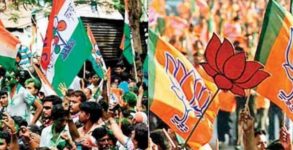We know now that the Indian economy is in the midst of a slowdown. As per latest estimates, amid coronavirus pandemic, India’s gross domestic product (GDP) witnessed a contraction of 7.3 per cent for the entire fiscal year. This is the first full-year contraction in the Indian economy in the last four decades since 1979-80, when GDP had shrunk by 5.2 per cent. This is also the second straight quarter of expansion since India exited a rare recession.
Amidst lockdown and restrictions on mobility, the unemployment rate touched 14.5% in the week ended May 16, 2021, and rose further to 14.7% for the week ended May 23, according to CMIE. As per Indian government’s periodic labour force survey (PLFS) data, country’s unemployment rate was 6.1% in 2017-18, a 45-year high.
Data from the Periodic Labour Force Survey of 2017-18 showed that unemployment was at a four-decade high that year and over 17% of rural men in the 15-29 age group were unemployed, triple the number in 2011-12.
There is ample evidence today that demonetisation in late 2016 resulted in a decline in incomes, an extended slump in domestic agricultural trade and high levels of informal debt. While academic evidence on the impact of the Goods and Services Tax (GST) is more limited, there is a sense that its implementation undermined the condition of those working in small and medium enterprises. International organisations too have attributed slow growth to the cut back of spending and disappointing tax collections after GST. By many accounts, growth rates in wages have decelerated somewhat in the past five years, with the growth in the construction wages reportedly decreasing.
The impact on common people’s lives because of all these developments must have been severe. Even before the slowdown set in, consumption levels had fallen. Recent data leaked from the National Sample Survey (NSS) on household consumption expenditure in 2017-18 (a report that was officially not released and has since been scrapped) records a significant 9% drop in rural expenditure, including on staples, between 2011-12 and 2017-18. This is the first time in half a century, since the early 1970s, that consumption has shown a fall. The situation with regards to the rural economy, where most of the country resides, is much worse. The rural consumption spending declined by 8.8% the average monthly spending on food declined by a whopping 10% and rural unemployment increased by 8% between FY11-12 and FY17-18.
However, the government while refusing to acknowledge the economic slowdown in all its gravity, announced relief in the budget through schemes like slashing corporate taxes and income tax cuts to counter the problem, hoping things would work. But schemes like these are mainly skewed towards the richest and don’t work in favour of the people who need money in their pockets to sustain their demand.
Therefore, in the current slowdown, given the sharp fall in consumption growth, government spending on income and employment support schemes which puts money in the hands of people could have led to a boost in demand via a multiplier effect.
In the Mahatma Gandhi National Rural Employment Guarantee Act, the Government has a potentially effective, even essential, instrument to address the current economic emergency in rural areas. This flagship employment scheme was yet another source of liquidity infusion and, again, a pre-existing programme that the government could deploy to support rural incomes during a crisis. Rural consumption, in turn, provided some cushion to the economy and preventing a bad situation from turning much worse.
Unfortunately, at a time when the economic predicament of the poor is more precarious than it has been in a long time, access to a number of social protection programmes have been severely undermined.
It is well known fact that, Government spending is probably the key to see how the rural economy’s growth or consumption growth is sustained.But if the Union Budgets of 2019-20 and 2020-21 are anything to go by, it appears that the Government is chipping away at the architecture of social policy in India, on the one hand via restricting allocations and, on the other, through the dilution of social protection schemes, even those that form part of the National Food Security Act.
As per latest budget, The Union government’s budgetary allocation for the Mahatma Gandhi National Rural Employment Guarantee Act will reduce the number of person days in 2021-22 from what the job generation programme has achieved in the current year, experts said.
Union Finance Minister Nirmala Sitharaman’s Budget 2021-22 allocates Rs 73,000 crore for MGNREGA, 34.52 per cent below the Revised Estimate of Rs 111,500 crore for 2020-21. Budgetary Estimate for 2020-21 was Rs 61,500 crore; In 2019-20, Rs 71,686.70 crore was spent on the programme.
The amount allocated for next year is Rs 38,500 crore less than the Revised Estimate for 2020-21. While the total number of person days generated so far has touched 3.4 billion, the government has provisioned for only about 2.7-2.8 billion person days for next year. This will limit the scope of employment and will result in indefinite delays in wage payments in the coming year.
It seems disappointing that the Government of India had ignored the current rural employment distress even though there was a need to maximise the spending in MGNREGA for enhancing rural demands seeing the current pandemic and slowdown.
The pandemic has already shown that there is heavy dependence on MGNREGA for employment in the country and the government needed to push the scheme by taking a number of measures.
The massive underestimation in the budget allocation will only result in distress in vulnerable households. Thus, a smaller budgetary allocation in MGNREGA in the present economic condition implies lesser money in the hands of the public. What ensues is a further fall in demand and hence, GDP and a greater rural distress in the economy which the government has decided to not deal with.
The MGNREGA was designed and enacted as law by the United Progressive Alliance (UPA) in 2005. The idea of the scheme is to provide livelihood security in rural areas and guarantees 100 days of employment to a household per year at a predetermined wage.
The basic tenet of the scheme was to ensure social security to rural households. This scheme was attacked by PM Narendra Modi as he said “My political acumen tells me that MGNREGA should not be shut down. I will not make such a mistake because MGNREGA is a living monument of your failures”.
Since then, however, the Modi-led government has relied heavily on the MGNREGA to reach the most vulnerable in rural India. After consecutive droughts and low farm prices, the government decided to increase allocation under MGNREGA. In fact in 2015-16, few months after Modi’s criticism, his government even increased allocation, mid-year, under the scheme faced by a drought.
The scheme, which has been described as the ‘employer of last resort’, assumed particular significance in the last few years as demonetisation led to a decline in wages. Given that rural India was already dealing with a crisis, Sudha Narayanan, associate professor at the Indira Gandhi Institute of Development Research, wrote – before the lockdown was imposed – that MGNREGA is a “potentially effective, even essential, instrument to address the current economic emergency in rural areas, even if it might be insufficient as a stand-alone intervention.”
The increased demand under MGNREGA points to a dire need of job creation in rural India. The lack of alternate job opportunities, falling farmer incomes, rising unemployment have all led to increasing agricultural distress. Yet, the resistance to increase budgetary allocation to scheme like MGNREGA points to the government’s inability to address the problem.
Given the economic slowdown, and lack of quality jobs in India, increased budget allocations to schemes like MGNREGA and PM-KISAN was the need of the hour. The lower allocation has led to lost opportunities on two counts. The first is the lost opportunity to boost rural consumption, and the second is the lack of a social safety net for the economically vulnerable sections of society.
Rural India has emerged as the saviour of the shattered Indian economy. From Ratan Tata to the governor of the Reserve Bank of India, everybody is betting on the consumption demand growth in rural areas to boost the novel coronavirus disease (COVID-19) pandemic-stricken economy.
So, the hope is that ultimately rural India — often perceived to be a cause of distress to the overall economy — will see the country through to an economic growth of ‘zero per cent’. The Indian economy is under contraction and reaching a ‘zero per cent’ growth rate also involves a significant growth in the economy. This will be a rather cheerful piece of news. While COVID-19 posed a threat to the rural economy and people on various fronts, it also brought newer opportunities that could help to grow the rural economies. The large influx of labour in rural areas enables the availability of a trained labour force that could be engaged in rural industries. Decentralization of economic zone by having clusters of industries in the rural areas would help to provide employment to people locally while bringing down the manufacturing costs and will facilitate India becoming the leading manufacturer for the global economy. Also there is need for proper skill gap analysis and demand driven approach to mobilize rural youth and provide them skill development trainings as part of MGNREGA. Collaboration is the key to achieve this by Government, Corporates, and not-for-profits coming together and executing by leveraging the resources and extending their expertise.
Until the government is ready to implement solutions to deal with low consumption spending and low demand in a slowing economy facing rural distress and absence of jobs, India will be prone to being knee deep in crisis.
The country is already paying a heavy price due to the government’s unpreparedness to deal with the health crisis. The Centre should pull up their socks and be prepared in advance to deal with the economic crisis which will only intensify in the coming times.


















